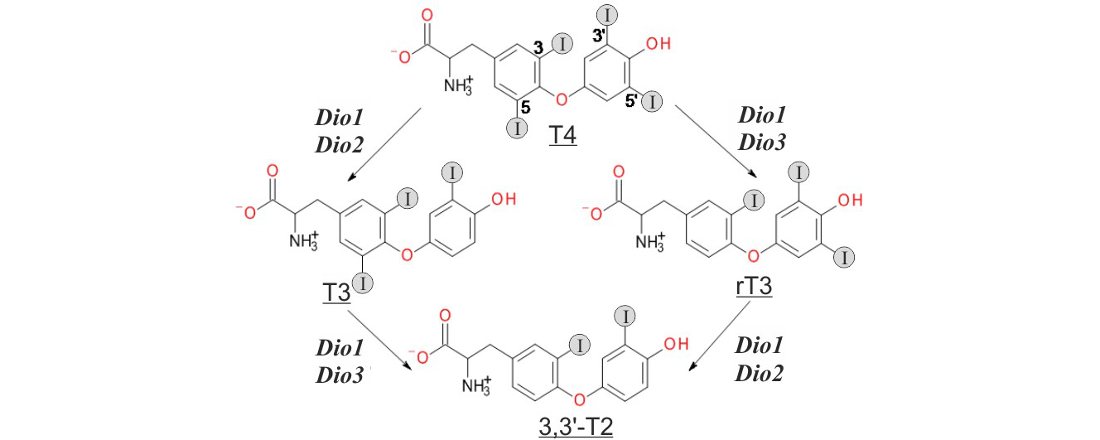Redox Signaling
Redox signaling and redox signaling enzymes
A variety of redox enzymes has signaling functions and is implicated in metabolic regulation, aging, and aging-related diseases. We previously analyzed the function of p66shc and could establish a redox activity and a regulatory interaction with Prx1.
Our current focus lies on Iodothyronine Deiodinases, a family of transmembrane proteins with key functions in the activation and deactivation of thyroid hormones. The major secreted product of the thyroid gland is thyroxine (T4), and its site specific deiodination yields T3, the major active hormone form. A subsequent, inactivating deiodination converts T3 to T2. The deiodinations are catalyzed by three Iodothyronine Deiodinase (Dio) isoforms (Dio1, Dio2, Dio3), which differ in the iodine positions they can attack. The Dio isoforms feature homolog catalytic domains and share many architectural and catalytic properties. They have an active site selenocysteine (Sec) and an N-terminal transmembrane region relevant for dimerization, which is required for the enzyme’s activity, a unique, Sec-dependent reductive deiodination of the T4/T3 aromatic ring systems. Dio enzymes appear to be attractive drug targets for modulating the thyroxine system, but a lack of molecular understanding of Dio has so far hampered the development of such compounds. As a first step for understanding Dio catalysis and specificity, we solved a crystal structure of an inactive, monomeric Dio3 catalytic core by using soluble Sec->Cys mutant.

Crystal structure of mouse Dio3 catalytic domain with thyronine ligand (sticks; carbon atoms in yellow, iodine atoms in magenta) modeled in the substrate binding region. The catalytic SeCys (replaced by Cys) is shown as grey/yellow sticks next to the inner ring iodine. An additional Cys (grey/yellow) and a Ser (grey/red) likely contributing to catalysis are also shown as sticks.
Through our structural and biochemical analyses, we obtained first insights in active site and substrate binding pocket and identified features resembling peroxiredoxins, which enabled us to propose a complete mechanism for Dio catalysis. We currently try to obtain further insights in Dio structure and catalysis, and to use our mechanistic insights for the development of isoform-specific Dio inhibitors.
Selected publications:
U. Schweizer, C. Steegborn (2015) Thyroid hormones-From Crystal Packing to Activity to Reactivity. Angew. Chem. Int. Ed Engl. 54, 12856-8.
U. Schweizer, C. Schlicker, D. Braun, J. Köhrle, C. Steegborn (2014). Crystal structure of mammalian selenocysteine-dependent iodothyronine deiodinase suggests a peroxiredoxin-like catalytic mechanism. Proc. Natl Acad. Sci. USA 111, 10526-31.
M. Gertz, F. Fischer, D. Wolters, C. Steegborn (2008) Activation of the life-span regulator p66Shc through reversible disulfide bond formation. Proc. Natl Acad. Sci. USA 105, 5705-5709.

